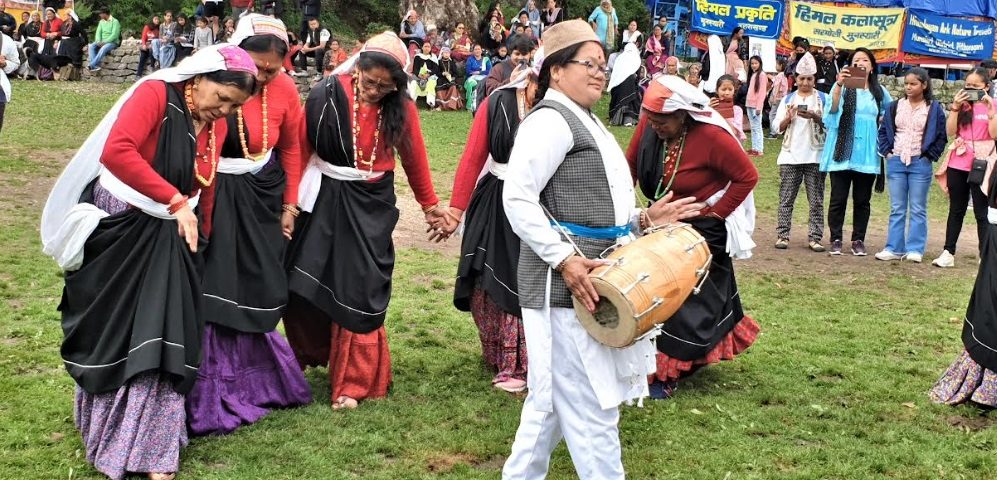
Kamal Mehra : To serve the nation with honour
July 21, 2022
Esha Mehta : Life is a beautiful equation
November 20, 2022Himal Kalasutra Forest Festival- 2022: A celebration of Himalayan Nature and Culture

Nestled in the greater Himalayan ranges and serving as a gateway to Trans-Himalayan valleys bordering Tibet, Munsiari is a typical mountain town blessed with a backdrop of magnificent peaks of the Panchachuli massif. It’s a popular destination for trekkers and tourists who want to experience the natural beauty of the landscape and the hospitality of hill people.
As is the case with many places in the Himalayas, Munsiari transformed itself with the arrival of modernity in the form of better road connectivity and telecommunications. Burgeoning population, dwindling forest resources, increasing pollution put a severe strain on the local natural environment. Agriculture and animal husbandry are the main sources of income and the recent growth in the tourism industry provides seasonal but limited economic opportunities for the local population.
Since 2009, Himalayan Education Foundation (HEF) has been partnering with organisations and individuals who are working for the wellbeing of the local communities and natural environment. For instance, as part of the Mountain Schools Initiative, HEF has enabled the active participation of school children and youth in successive festivals through its support of Himalayan Ark, a community-based enterprise based in Sarmoli, a village adjacent to Munsiari. Himalayan Ark has over the years created livelihood opportunities through tourism that is linked with active stewardship of the natural and cultural resources of the region, particularly the forest commons. Along with the active involvement of Maati, a women’s collective and Himal Prakriti, a Trust for Nature, Himalayan Ark promotes education activities that create awareness about ecology among local kids and adults, leads afforestation and clean up campaigns, and organises workshops for skill development etc.
As the harsh Himalayan winter gives way to summer in May, the higher Himalayan valleys spring to life with agricultural and farming activities. Around this time of the year the village community of Sarmoli, along with Himalayan Ark, Maati and Himal Prakriti organises Himal Kalasutra, a two week long forest festival celebrating the culture and nature in Munsiyari. This year this event took place from the 19th to 29th May, attracting people from near and far. Creating awareness about the local natural environment and reconnecting with the heritage and culture are the main themes that run through the festival’s various activities.
Two days each were spent on the Bird Festival, Butterfly and Moths workshop, Storytelling and the use of social media. Sporting events like Run for Nature, the Khalia Trail Run, and ultimate frisbee had an enthusiastic participation not only by the locals but also people from different parts of Kumaon.
A visit to the State Forest Department’s Eco- Park and their Bird Tourism Growth Centre was a part of the Bird Festival. Presentations were made by experts on the status of the natural environment in the region. The festival culminates with the Mesar Forest Fair that attracted around 2000 people this year. Stalls showcasing and selling local products, local folk dances, drumming and festivities bring the Mesar Forest Pond alive on the day of the Fair.
“Sensitising the local population about environmental concerns is the first step” asserts Bina Nitwal, co-ordinator, Kalasutra. She is an active member of ‘Maati’, a women’s collective and self-help group based in Sarmoli that aims at women’s empowerment.
”We should be aware of the ecosystem we live in and the various threats to it before we take concrete action to safeguard it. We would like the local people to appreciate the biodiversity found in our forests and how important it is for the health of the ecosystem. Himalayas are well known for various herbs, including those used in a traditional medicine like Ayurveda. It’s a good idea for our youth to be knowledgeable about their natural heritage and interested in the rich traditional knowledge about the value of our plants and trees. So we organised special events for school going kids too.”
Recounting the success of the event, Malika Virdi, Founder- Director of Himalayan Ark says, “Thanks to the support from HEF that helped a total of 127 school students and 15 teachers from 7 Schools to participate in the festival. These students took part in the Nature Walks, Birding and Butterfly workshops, in discussions on impact of Social Media, Story telling sessions and playing Ultimate Frisbee.”
“The response was overwhelming and made us realise the hunger in the kids to connect deeply with their surroundings. We hope to continue to nurture the seeds sown through these summer events”, she informs.
The Himalayan economy is primarily based on agricultural activity. Manufacturing and service industries are non-existent. Hence chronic unemployment and migration of the youth to cities are huge challenges faced by the rural communities. Developing cottage industries and tapping the tourist potential are some of the ways they could address outmigration and unemployment.
“We have enabled the village community and the youth to develop environmental friendly and sustainable home stay initiatives. And the skills learned in the workshops are useful for them to conduct bird watching and butterfly spotting tours for our visitors”, states Bina.
Voicing the reasons for HEF’s involvement in such initiatives, Monica Lehner, a board director, says, “We are happy that the Himalayan Education Foundation is helping organisations such as Himalayan Ark, Maati and their associated community organisations like Himal Prakriti in creating awareness about the natural environment as well as fostering appreciation for the mountain communities’ cultural heritage in students and youth. They are its’ future custodians and beneficiaries.”
As for the local residents of Munsiyari and nearby villages, Himal Kalasutra and the Mesar Forest Fair are the events that make them aware of their own natural environment and the biodiversity it contains. It provides them an opportunity to celebrate and take pride in their heritage and culture. It’s a reminder for them to protect and safeguard these life-giving resources for their own and future generations’ prosperity and wellbeing.
—————-



